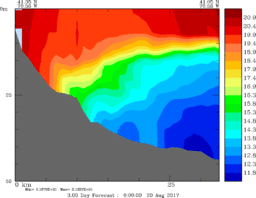Nantucket and Martha’s Vineyard – August 2017
|
P.F.J. Lermusiaux, P.J. Haley, S. Jana, C. Mirabito, C. Kulkarni, A. Dutt, A. Gupta, W. Ali Massachusetts Institute of Technology Center for Ocean Engineering Mechanical Engineering Cambridge, Massachusetts
|
Real-time modeling Data sources |

|

|
The NSF-ALPHA 2017 Real-Time Pilot Sea Exercise occurs in the Nantucket and Martha's Vineyard coastal region during August 11-18, 2017.
The specific objectives of the real-time pilot exercise are to: (i) forecast the regional high-resolution ocean fields and their probability, using our ESSE methodology; (ii) utilize these fields and our Lagrangian methods to forecast Lagrangian Coherent Structures and Coherent Sets; (iii) forecast the probability and quantify the uncertainty of such Lagrangian quantities using stochastic differential equations, and (iv) provide quantitative guidance on ocean dynamics, optimal drifter deployments and optimal adaptive sampling. We thank all of the NSF-ALPHA team members for their inputs and collaboration.
This research is sponsored by the National Science Foundation.
Real-time MSEAS Forecasting
- MSEAS Ocean Forecasts
Nowcast and Forecast Products
with dynamics descriptionsAnalyses and Forecasts Issued On August 2017 12 13 14
8am14
5pm15
8am15
5pm16
8am16
5pm17
8am17
5pm18
8am18
5pmOcean Physics Horizontal Maps Central Forecast X X X X X X X X X X X Mean and Uncertainty X Operational Vertical Section Central Forecast X X X X X X X X X X X Mean and Uncertainty X Lagrangian Coherent
StructuresLCS Maps Central Forecast X X X X X X X X X X X Mean and Uncertainty X X Drifters Trajectories
(0m, 12m, and 17m)Central Forecast X X X X X X X X X X X Ensemble Forecast Special Lagrangian Products Drifter release around No Man's Land X Drifter release for N-MV coastal current X X X X South Beach active drifter X X X X X X X X Recovery of Drifters X Dye Release Advisory X X Lagrangian Forecast Skill Evaluation X - Methods and Systems: The MIT-MSEAS Primitive-Equation (PE) ocean modeling system is utilized in real-time to provide ocean forecasts for Lagrangian transport and coherent structure analyses in the region. The modeling system was set-up in an implicit 2-way nesting configuration (200m resolution Martha's Vineyard domain and 600m resolution Shelf domain). Ensemble forecasts were initialized using ESSE procedures. The ocean forecasts are initialized using historical and synoptic ocean CTD data from the National Marine Fisheries Service (NMFS) and the Martha's Vineyard Coastal Observatory (MVCO), SST images from the Johns Hopkins University's Applied Physics Lab (JHU APL), and other data from varied sources of opportunity. These ocean simulations are forced by atmospheric flux fields forecast by the National Centers for Environmental Prediction (NCEP) and tidal forcing from TPXO8, but adapted to the high-resolution bathymetry and coastlines.
- MSEAS-processed atmospheric forcing flux forecasts:
NCEP NAM 3km August 2017 Forecast snapshot plots 9 10 11 12 13 14 15 16 17 18 19 20 Forecast data files (all fields) 00Z 00Z 00Z 00Z 00Z 00Z 00Z 00Z 00Z 00Z 00Z 00Z 06Z 06Z 06Z 06Z 06Z 06Z 06Z 06Z 06Z 06Z 06Z 06Z 12Z 12Z 12Z 12Z 12Z 12Z 12Z 12Z 12Z 12Z 12Z 12Z 18Z 18Z 18Z 18Z 18Z 18Z 18Z 18Z 18Z 18Z 18Z 18Z Daily average wind stress, E-P, heat flux, and SW Radiation Flux snapshot plots 9 10 11 12 13 14 15 16 17 18 19 20
NCEP HIRESW 5km August 2017 Forecast snapshot plots 9 10 11 12 13 14 15 16 17 18 Forecast data files (all fields) 00Z 00Z 00Z 00Z 00Z 00Z 00Z 00Z 00Z 00Z 12Z 12Z 12Z 12Z 12Z 12Z 12Z 12Z 12Z 12Z
- WHOI HF Radar data:
WHOI HF Radar August 2017 Velocity Snapshots 9 10 11 12 13 14 15 16 17 18 24-hour Average Velocity X X X X X X X X X X 62-hour Average Velocity X X X X X X X X X X - SST Images
- MSEAS-processed External Data
- Bathymetry and Model Domain
- Additional information
- Acknowledgements: We thank our NSF Alpha colleagues, especially Glen Gawarkiewicz for providing CTD and REMUS data from the R/V Tioga and Anthony Kirincich and Siavash Ameli for providing HF Radar data in real-time. We wish to thank Matthew Pyle, Eric Rogers, Geoff DiMego, and Arun Chawla of NCEP for help and support for atmospheric forcing data, NOAA for supplying buoy data, MVCO for providing both ocean and atmospheric data, the JHU APL for providing processed SST images, and Tamara Holzwarth-Davis and Paula Fratantoni of NOAA for support for ocean historical/climatological data from NMFS.
| Top of page |
Data sources
- Ocean synoptic
- WHOI Martha's Vineyard Coastal Observatory (MVCO)
- The Global Temperature and Salinity Profile Programme (GTSPP)
- National Data Buoy Center Real-Time & historical data from moored buoy & C-MAN stations
- SST Images
- Ocean historical/climatological
- NOAA/NOS tidal elevation stations
- CO-OPS current station data (historical)
- The Global Temperature and Salinity Profile Programme (GTSPP)
- Data sets & products NOAA National Centers for Environmental Information
- World Ocean Database (WOD)
-
Northeast Fisheries Science Center Ecosystem Processes Division Oceanography Branch
NMFS. Includes data from CTDs, fish hauls, hull-mounted sensors, eMOLT
moorings, drifters, etc.
- Hydrographic Conditions of the Northeast Continental Shelf Northeast Fisheries Science Center Oceanography Branch
- Data/Mapping Interface Northeast Fisheries Science Center, Oceanography Branch
- Atmospheric forcing
- Weather Research and Forecasting (WRF) Model Real-Time Forecasts
- National Centers for Environmental Prediction (NCEP) products:
- High-Resolution Window (HIRESW) (5 km resolution):
- North American Model (NAM) (3 km resolution):
- Global Forecast System Model: version 4 (GFS), at 0.5 degree resolution (GFSp5) and also at 0.25 degree resolution (GFSp25)
- The European Centre for Medium-Range Weather Forecasts (ECMWF) ERA Intrim (global Re-Analysis)
- Coupled Ocean / Atmosphere Mesoscale Prediction System (COAMPS)
- Navy Global Environmental Model (NAVGEM) products:
| Top of page |
















